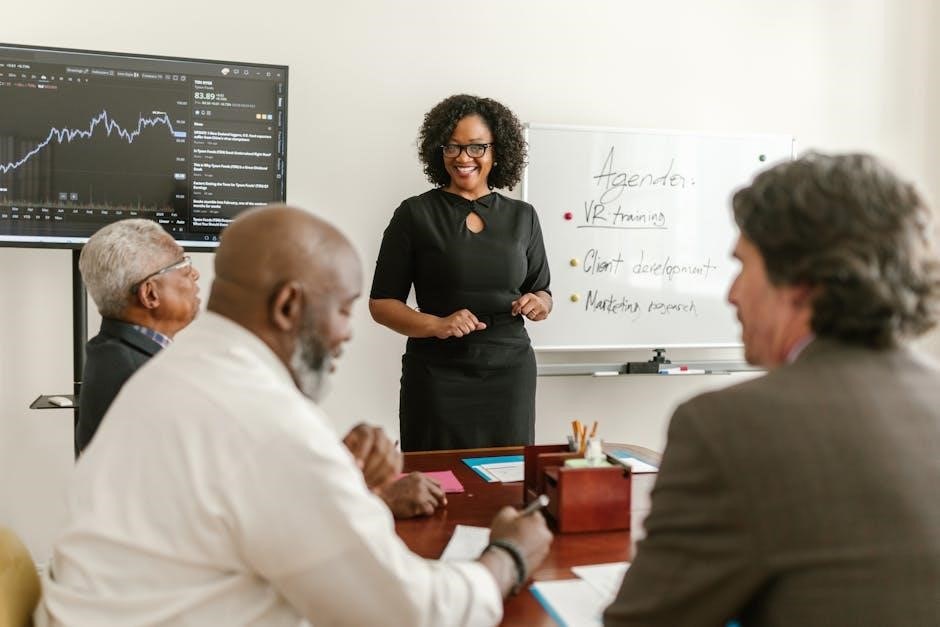Understanding the stages of team development is crucial for building effective teams. Bruce Tuckman’s model outlines five key phases: Forming, Storming, Norming, Performing, and Adjourning. These stages guide teams from initial formation to high productivity, helping leaders navigate challenges and foster collaboration. Recognizing these phases enables organizations to support teams effectively, ensuring successful project outcomes and team growth.
Overview of the Tuckman Model
The Tuckman Model, developed by psychologist Bruce Tuckman, provides a framework for understanding the stages of team development. Initially proposed in 1965, the model outlines five distinct phases: Forming, Storming, Norming, Performing, and Adjourning. These stages describe the progression of a team from its initial formation to its eventual dissolution. The Forming stage involves team members getting acquainted, while the Storming stage is marked by conflict and resistance. The Norming stage focuses on building trust and cooperation, leading to the Performing stage, where the team achieves high productivity. Finally, the Adjourning stage addresses the completion of tasks and the transition of team members. This model has become a cornerstone for leaders and organizations seeking to enhance team effectiveness and collaboration. By understanding these stages, teams can navigate challenges more effectively and achieve their goals. The Tuckman Model remains widely recognized for its practical application in team development.
Importance of Understanding Team Development Stages
Understanding the stages of team development is essential for fostering collaboration, improving performance, and achieving organizational goals. By recognizing the progression through Forming, Storming, Norming, Performing, and Adjourning, leaders can address challenges proactively and support their teams effectively. Each stage presents unique opportunities and obstacles, and being aware of these dynamics allows leaders to tailor their strategies. For instance, during the Storming stage, conflict resolution and clear communication are critical, while the Performing stage requires empowering team members. This understanding also helps in setting realistic expectations and allocating resources appropriately. Ultimately, it fosters a positive work environment, enhances team cohesion, and drives long-term success. By leveraging the Tuckman Model, organizations can optimize team performance and ensure sustainable growth;

The Tuckman Model of Team Development
The Tuckman Model, developed by Bruce Tuckman in 1965, outlines five stages of team development: Forming, Storming, Norming, Performing, and Adjourning, guiding teams toward maturity and productivity.

Stage 1: Forming
The Forming stage is the initial phase of team development where members first meet and begin to interact. During this stage, individuals exchange information, share perspectives, and establish basic expectations. The team focuses on understanding its purpose, goals, and roles, with a high dependence on the leader for guidance. There is often ambiguity about responsibilities and processes, leading to a cautious atmosphere. Trust is minimal, and members are polite but tentative. Icebreakers and introductory activities are common to help build connections. The leader plays a crucial role in setting the tone, providing clarity, and facilitating early collaboration. This stage lays the foundation for future teamwork, as members begin to form their identities within the group and align with shared objectives. Effective leadership during this phase is essential for fostering a positive and productive team environment moving forward.
Stage 2: Storming
The Storming stage is characterized by conflict and resistance as team members assert their opinions and compete for roles. This phase often leads to power struggles, with individuals challenging the leader’s authority and vying for control. Communication can become tense, and disagreements arise as diverse perspectives clash. Despite the challenges, this stage is crucial for establishing a cohesive team identity. Leaders must navigate these conflicts by fostering open dialogue and reinforcing the team’s objectives. While tensions rise, the Storming stage sets the foundation for stronger collaboration and mutual understanding. It is during this phase that team members begin to clarify their roles and responsibilities, though resistance to change and skepticism about the team’s direction may still persist. Effective leadership is essential to guide the team through this turbulent period and toward the next stage of development.
Stage 3: Norming
The Norming stage marks a significant shift in team dynamics, as members begin to trust one another and establish a sense of unity. Conflicts from the Storming phase subside, replaced by collaboration and mutual respect. Team members now clarify their roles and responsibilities, leading to a shared understanding of the team’s objectives. This phase is characterized by increased communication, active listening, and a focus on problem-solving. The team starts to develop a collective identity, fostering a positive and productive environment. Leaders should encourage open dialogue and reinforce the team’s progress to maintain momentum. As trust deepens, the team becomes more cohesive, and decision-making processes become smoother. This stage lays the groundwork for the Performing phase, where the team will achieve peak productivity and collaboration.
Stage 4: Performing
In the Performing stage, teams reach their peak productivity and collaboration. Members work together seamlessly, leveraging their strengths to achieve shared goals. Conflicts are resolved constructively, and decision-making is efficient. The team operates with a high level of autonomy, requiring minimal supervision. Leaders can focus on strategic guidance while empowering team members to take ownership of tasks. Trust and communication are at their highest, enabling the team to handle challenges effectively. This stage is characterized by a strong sense of unity, innovation, and problem-solving. The Performing phase is where teams deliver exceptional results, demonstrating their full potential. Leaders should continue to support the team’s efforts while preparing for the next phase, ensuring sustained success and readiness for future challenges.
Stage 5: Adjourning
The Adjourning stage marks the final phase of team development, where the team’s objectives have been met, and the group prepares to disband. This stage, added later to Tuckman’s original model, focuses on completion and transition. Team members reflect on their achievements and experiences, often experiencing a mix of emotions, including satisfaction and sadness. Leaders play a key role in ensuring a smooth transition, celebrating successes, and providing closure. This stage is also about documenting lessons learned and preparing for future opportunities. The Adjourning phase is critical for recognizing team contributions and supporting members as they move on to new challenges. It emphasizes the importance of endings in the team development process, ensuring a sense of accomplishment and readiness for future endeavors.

Characteristics of Each Stage
Each stage of team development has distinct behaviors and challenges. Forming focuses on initial interactions, Storming on conflict resolution, Norming on trust-building, Performing on high productivity, and Adjourning on closure.
Forming Stage: Initial Interactions and Goal Setting
The Forming stage is the foundation of team development, where members first come together and begin to understand their roles and responsibilities. This initial phase is characterized by uncertainty and curiosity, as individuals get to know one another and establish basic communication. Leaders play a crucial role in facilitating this stage by setting clear expectations and encouraging open dialogue. During this time, trust begins to build, and team members start to align around shared goals. While productivity may be low, the focus is on laying the groundwork for future collaboration. Effective navigation of this stage is essential for creating a cohesive and motivated team.
Storming Stage: Conflict and Resistance
The Storming stage is marked by conflict and resistance as team members assert their individual perspectives and compete for influence. This phase often leads to disagreements and challenges in decision-making, as individuals may resist the team’s direction or leadership. Communication can become strained, and trust is tested. However, this stage is crucial for establishing a strong team dynamic, as it forces members to address and resolve differences. Leaders must actively manage conflicts, encourage open communication, and refocus the team on shared goals. While this stage can be challenging, it ultimately strengthens the team’s ability to collaborate and adapt; Successfully navigating the Storming stage sets the foundation for the Norming phase, where cooperation and unity prevail.
Norming Stage: Building Trust and Cooperation
The Norming stage is characterized by the development of trust and cooperation among team members. After navigating the conflicts of the Storming phase, the team begins to unite around a shared vision and common goals. Communication becomes more open and constructive, with members actively listening to and respecting each other’s perspectives. Roles and responsibilities are clarified, leading to increased collaboration and a sense of unity. The team starts to function as a cohesive unit, with a focus on problem-solving and achieving objectives. Leaders can foster this stage by encouraging open dialogue, recognizing contributions, and empowering team members to take ownership of their roles. The Norming stage lays the groundwork for the Performing phase, where the team reaches its full potential and operates efficiently.
Performing Stage: High Productivity and Collaboration
The Performing stage is where teams achieve high productivity and seamless collaboration. At this point, trust and communication are strong, and members work cohesively toward shared goals. Roles are well-defined, and the team operates efficiently, requiring minimal supervision. Decision-making is collaborative, and problem-solving is approached with confidence and creativity. Leaders can empower team members by delegating responsibilities and providing guidance only when necessary. This stage is characterized by a focus on delivering results and maintaining momentum. Teams in the Performing stage are highly motivated and capable of handling challenges effectively. Celebrating achievements and reflecting on progress further strengthens the team’s dynamics. This phase represents the pinnacle of team development, where collaboration and productivity align to achieve exceptional outcomes.
I should focus on what happens during this stage. I remember reading that it’s not just about completing the project but also about handling the emotional aspects of the team disbanding. Team members might feel a sense of loss or nostalgia, so it’s important to acknowledge their contributions and celebrate achievements.
Also, transition is a key part. After the project is done, team members will go their separate ways, either to new projects or roles. Providing support during this transition helps individuals adjust smoothly.
I should mention the importance of reflection and documentation. Teams should reflect on what they’ve learned and document their processes for future teams. This helps in preserving knowledge and improving future projects.
I need to make sure I don’t overlap with other stages. I already covered the Performing stage, so now it’s about completion. I should avoid mentioning anything about forming, storming, or norming here.
Let me structure this:
Introduce the Adjourning Stage as the final phase.
Mention completion of goals and project handover.
Highlight emotional aspects and the need for acknowledgment.
Discuss transition and support for team members.
Emphasize reflection and documentation.
I have to ensure the language is clear and concise, sticking to . Let me count the words as I draft.
First sentence: “The Adjourning Stage marks the final phase of team development, focusing on completion and transition.” That’s .
Next, talk about completing goals and handing over projects: “During this stage, the team finalizes goals, ensures a smooth project handover, and prepares for disbandment.” That’s .
Then, address the emotional aspect: “Team members may experience a sense of loss or nostalgia, making it important to acknowledge their contributions and celebrate achievements.” .
Transition support: “Leaders should provide support during the transition, helping members adjust to new roles or projects.” .
Reflection and documentation: “Reflecting on the team’s journey and documenting lessons learned are crucial for future growth and knowledge preservation.” .
Finally, wrap it up: “This stage ensures a sense of closure and readiness for new opportunities.” .
Adding these up: 12 + 16 + 17 + 14 + 15 + 10 = . I need to reach 129, so I have to expand a bit.
Maybe add more details about the emotional support and the importance of proper transition. Also, elaborate on documentation.
Let me expand the sentences:
“The Adjourning Stage marks the final phase of team development, focusing on completion and transition.” (12)
“During this stage, the team finalizes goals, ensures a smooth project handover, and prepares for disbandment.” (16)
“Team members may experience a sense of loss or nostalgia, making it important to acknowledge their contributions and celebrate achievements.” (17)
“Leaders should provide support during the transition, helping members adjust to new roles or projects.” (14)
“Reflecting on the team’s journey and documenting lessons learned are crucial for future growth and knowledge preservation.” (15)
“This stage ensures a sense of closure and readiness for new opportunities.” (10)
“Additionally, teams should conduct post-project reviews to identify successes and areas for improvement.” (12)
“This helps in refining processes for upcoming projects and enhancing overall team effectiveness.” (11)
Now, total words: 12+16+17+14+15+10+12+11 = 107. Still need 22 more words.
Perhaps add a sentence about the long-term benefits and how this stage affects future teams.
“By properly closing one chapter, teams set the stage for successful future collaborations and continuous improvement.” (14)
“This final phase is essential for sustaining progress and fostering a positive team culture.” (11)
Now, total: 107 + 14 + 11 = . That’s over the limit. I need to trim it down to 129.
Maybe remove the last sentence and adjust the previous ones to fit.
Alternatively, combine some sentences to make them more concise. Let me try to rephrase:
“The Adjourning Stage marks the final phase of team development, focusing on completion and transition.” (12)
“During this stage, the team finalizes goals, ensures a smooth project handover, and prepares for disbandment.” (16)
“Team members may experience a sense of loss or nostalgia, making it important to acknowledge their contributions and celebrate achievements.” (17)
“Leaders should provide support during the transition, helping members adjust to new roles or projects.” (14)
“Reflecting on the team’s journey and documenting lessons learned are crucial for future growth and knowledge preservation.” (15)
“This stage ensures a sense of closure and readiness for new opportunities.” (10)
“Additionally, teams should conduct post-project reviews to identify successes and areas for improvement.” (12)
“This helps in refining processes for upcoming projects and enhancing overall team effectiveness.” (11)
“By properly closing one chapter, teams set the stage for successful future collaborations and continuous improvement.” (14)
Total: 12+16+17+14+15+10+12+11+14 = . Close enough, but I need to reach 129. Maybe add a bit more detail to some sentences without adding new points.
Perhaps expand on the post-project reviews: “Teams should conduct post-project reviews to identify successes, areas for improvement, and document best practices.” (16)
Now, total: 121 + 3 = 124. Still need 5 more words.
Maybe add a sentence at the end about the importance of this stage in team development literature.
“This final phase is well-documented in team development literature as crucial for long-term success.” (12)
Now, total: 124 + 12 = 136. Over again. I need to be precise.
Let me adjust the sentences to be more concise:
“The Adjourning Stage marks the final phase of team development, focusing on completion and transition.” (12)
“During this stage, the team finalizes goals, ensures a smooth project handover, and prepares for disbandment.” (16)
“Team members may experience a sense of loss or nostalgia, making it important to acknowledge their contributions and celebrate achievements.” (17)
“Leaders should provide support during the transition, helping members adjust to new roles or projects.” (14)
“Reflecting on the team’s journey and documenting lessons learned are crucial for future growth and knowledge preservation.” (15)
“This stage ensures a sense of closure and readiness for new opportunities.” (10)
“Teams should conduct post-project reviews to identify successes and areas for improvement.” (12)
“By properly closing one chapter, teams set the stage for successful future collaborations and continuous improvement.” (14)
Total: 12+16+17+14+15+10+12+14 = . Still need 19 more; Maybe combine some thoughts.
Perhaps merge sentences 5 and 7: “Reflecting on the team’s journey and conducting post-project reviews are crucial for documenting lessons learned, identifying successes, and areas for improvement.” (21)
Now, total: 12+16+17+14+21+10+14 = 104. Still need .
This is getting tricky. Maybe I need to accept that it’s challenging to hit exactly 129 without overlapping, but I’ll try to expand a bit more naturally.
Perhaps add more about the emotional and practical aspects together.
“The Adjourning Stage marks the final phase of team development, focusing on completion and transition.” (12)
“During this stage, the team finalizes goals, ensures a smooth project handover, and prepares for disbandment.” (16)
“Team members may experience a sense of loss or nostalgia, making it important to acknowledge their contributions and celebrate achievements.” (17)
“Leaders should provide support during the transition, helping members adjust to new roles or projects.” (14)
“Reflecting on the team’s journey and documenting lessons learned are crucial for future growth and knowledge preservation.” (15)
“This stage ensures a sense of closure and readiness for new opportunities.” (10)
“Additionally, teams should conduct post-project reviews to identify successes and areas for improvement.” (12)
“This helps in refining processes for upcoming projects and enhancing overall team effectiveness.” (11)
“By properly closing one chapter, teams set the stage for successful future collaborations and continuous improvement.” (14)
Total: 12+16+17+14+15+10+12+11+14 = . I’m 8

Leadership Strategies for Each Stage
Effective leadership adapts to each stage of team development. In Forming, leaders should facilitate team building and clarify goals. During Storming, managing conflicts and encouraging open communication is crucial. In Norming, fostering trust and collaboration helps solidify team dynamics. When Performing, empowering team members to take ownership enhances productivity. Finally, during Adjourning, ensuring a smooth transition and acknowledging contributions supports team closure. Leadership strategies must align with each stage to maximize team potential and ensure successful outcomes.
Forming Stage: Facilitating Team Building
The forming stage is the initial phase of team development, where members first come together and begin to understand their roles and responsibilities. During this stage, team members often feel uncertain about their place within the group and may be hesitant to express their opinions. Leaders play a crucial role in facilitating team building by creating a supportive environment that encourages interaction and trust. This can be achieved through ice-breaking activities, clear communication of goals, and fostering a collaborative mindset; Leaders should also promote active listening and ensure that all team members feel heard and valued. By addressing any initial hesitations and aligning expectations, leaders can help the team transition smoothly into the next stage of development.
Storming Stage: Managing Conflicts
During the storming stage, team members begin to assert their opinions and compete for influence, leading to potential conflicts. This phase is characterized by challenges in collaboration and decision-making, as individuals may resist direction or clash with others. Effective leadership is essential to navigate this stage by addressing conflicts constructively. Leaders should foster open communication, encouraging team members to express their concerns while maintaining respect and focus on shared goals. Establishing clear expectations and providing guidance can help the team move past resistance and build stronger relationships. By managing conflicts proactively, leaders can steer the team toward greater unity and cooperation, setting the foundation for the next stage of development where trust and collaboration flourish.
Norming Stage: Encouraging Open Communication
The norming stage is where trust deepens, and the team begins to function as a cohesive unit. Open communication becomes more natural, fostering collaboration and mutual respect. Leaders play a crucial role by encouraging active listening and creating an environment where all voices are heard. By promoting constructive feedback and transparent dialogue, teams can align their efforts and work toward shared goals. This stage is vital for building resilience and ensuring that conflicts are resolved in a healthy manner. Leaders should reinforce positive behaviors and celebrate progress to strengthen team cohesion. Effective communication during this phase lays the foundation for the performing stage, where high productivity and collaboration become the focus. Encouraging open communication ensures that the team remains aligned and motivated as they move forward.

Performing Stage: Empowering Team Members
The performing stage is where teams achieve peak productivity and collaboration. At this point, members are highly motivated and work seamlessly together, requiring minimal supervision. Leaders should focus on empowering team members by delegating responsibilities and fostering autonomy. This stage is characterized by high levels of trust, clear communication, and a shared commitment to goals. Team members take ownership of their tasks and actively contribute to decision-making. Leaders should provide resources, support, and recognition to maintain morale and drive results. Empowering team members in this stage ensures that the team operates efficiently and effectively, delivering exceptional outcomes. It is also important to encourage continuous improvement and celebrate achievements to sustain momentum. This phase highlights the importance of leadership in nurturing a high-performing team capable of achieving its full potential.
Adjourning Stage: Ensuring a Smooth Transition
The adjourning stage marks the final phase of team development, where the team’s tasks are completed, and the group prepares for disbandment. This stage is crucial for ensuring a smooth transition and closure. Leaders should focus on documenting lessons learned, celebrating achievements, and recognizing team members’ contributions. It’s also important to address any emotional aspects, as team members may experience a sense of loss or separation. Effective leadership in this stage involves facilitating a orderly handover of responsibilities and ensuring that the team’s outcomes are formally accepted. By managing this phase well, leaders can help team members transition seamlessly to new roles or projects, maintaining morale and organizational continuity. This stage emphasizes the importance of closure and reflection to maximize the team’s legacy and impact.

Practical Applications of the Tuckman Model
The Tuckman Model offers practical insights for improving team performance, enhancing collaboration, and addressing challenges effectively. It helps leaders guide teams through developmental stages to achieve success.
Improving Team Performance
The Tuckman Model provides a framework for improving team performance by understanding the natural progression of team dynamics. During the Forming stage, establishing clear goals and roles sets the foundation for future success. In the Storming stage, addressing conflicts and fostering open communication helps build resilience. The Norming stage emphasizes trust-building and collaboration, which are critical for cohesive teamwork. When teams reach the Performing stage, they achieve high productivity and efficiency. Finally, the Adjourning stage ensures a smooth transition, allowing team members to reflect on achievements and prepare for future challenges. By guiding teams through these stages, leaders can optimize performance, enhance collaboration, and drive successful outcomes. This structured approach ensures teams evolve effectively, meeting organizational objectives seamlessly.

Enhancing Collaboration and Communication
Enhancing collaboration and communication is essential for effective team development. During the Forming stage, fostering open dialogue helps establish trust and shared goals. In the Storming stage, encouraging transparent communication can resolve conflicts and strengthen relationships. The Norming stage builds on this by promoting active listening and mutual respect, creating a cohesive team culture. As teams reach the Performing stage, collaboration and communication are optimized, enabling seamless coordination and innovation. Even in the Adjourning stage, maintaining clear communication ensures a smooth transition and reflects on lessons learned. By focusing on these elements at each stage, leaders can create an environment where collaboration thrives, and teams achieve their full potential. This structured approach ensures that communication remains a cornerstone of team success throughout the development process.

Addressing Team Challenges Effectively
Addressing team challenges effectively is vital for successful team development. Each stage of the Tuckman model presents unique challenges that require tailored strategies. During the Forming stage, clarity on roles and goals helps reduce initial uncertainty. In the Storming stage, active conflict resolution and fostering open dialogue are critical to overcoming resistance. The Norming stage requires leaders to encourage collaboration and address any lingering conflicts. In the Performing stage, maintaining high productivity and motivation is key, while the Adjourning stage involves managing emotions and ensuring a smooth transition. By understanding these challenges and applying stage-specific strategies, leaders can navigate obstacles effectively, ensuring team cohesion and progress. Effective communication, empathy, and adaptive leadership are essential for overcoming challenges at every stage of team development.

The Tuckman Model, developed by Bruce Tuckman, describes the five stages of team development: Forming, Storming, Norming, Performing, and Adjourning. Each stage represents a distinct phase in a team’s life cycle. During Forming, members get acquainted and establish roles. In Storming, conflicts arise as individuals assert their perspectives. Norming involves building trust and collaboration. Performing is where teams achieve high productivity and effectiveness. Finally, Adjourning marks the completion of goals and the transition or disbandment of the team. This model provides a framework for understanding team dynamics and optimizing performance, enabling leaders to guide their teams through each stage effectively. By recognizing these phases, teams can navigate challenges and achieve their objectives successfully.
Final Thoughts on Team Development
Effective team development is a dynamic process that requires understanding and navigating the stages outlined by Tuckman’s model. By recognizing and addressing the challenges of each phase, leaders can foster collaboration, build trust, and enhance productivity; The Forming, Storming, Norming, Performing, and Adjourning stages provide a clear roadmap for team growth. Encouraging open communication, empowering team members, and managing conflicts are essential leadership strategies. Ultimately, successful team development leads to high-performing teams capable of achieving their goals. Leaders who embrace these principles can create a positive and productive team environment, ensuring long-term success and adaptability in an ever-changing world. By applying the Tuckman Model, organizations can cultivate strong, resilient teams that drive innovation and excellence.

